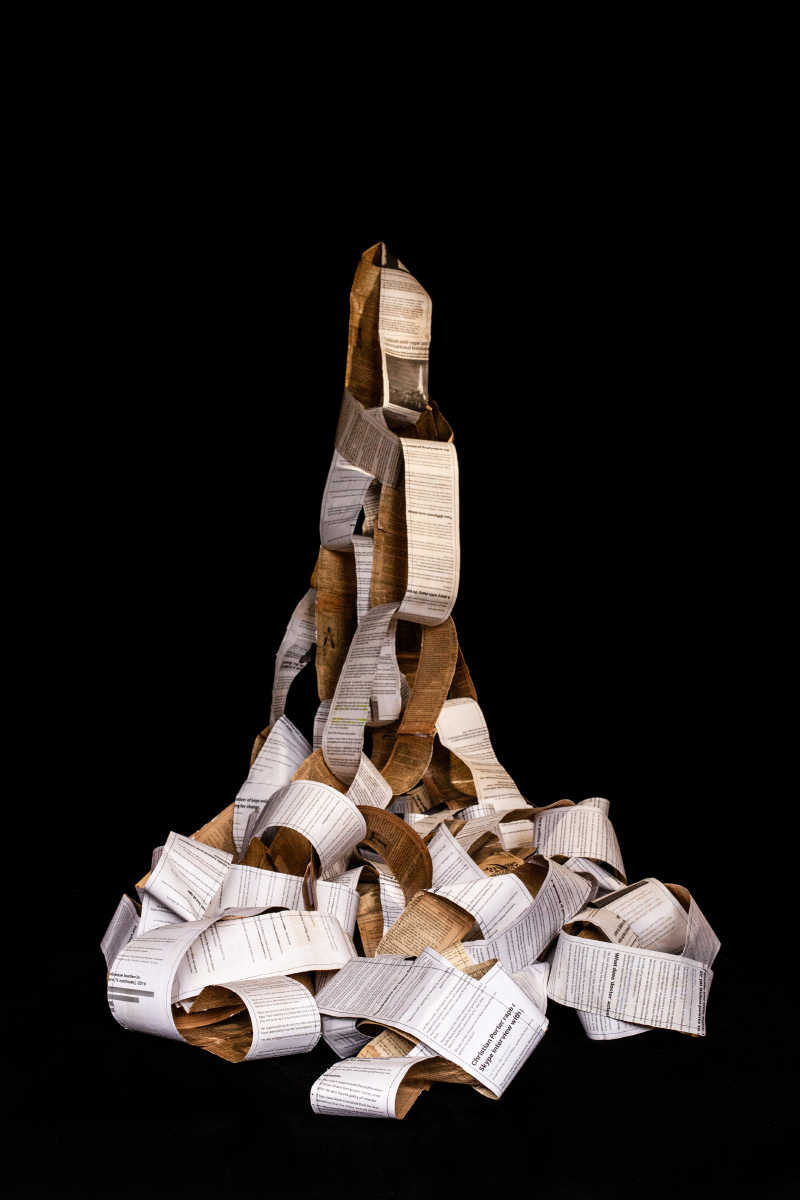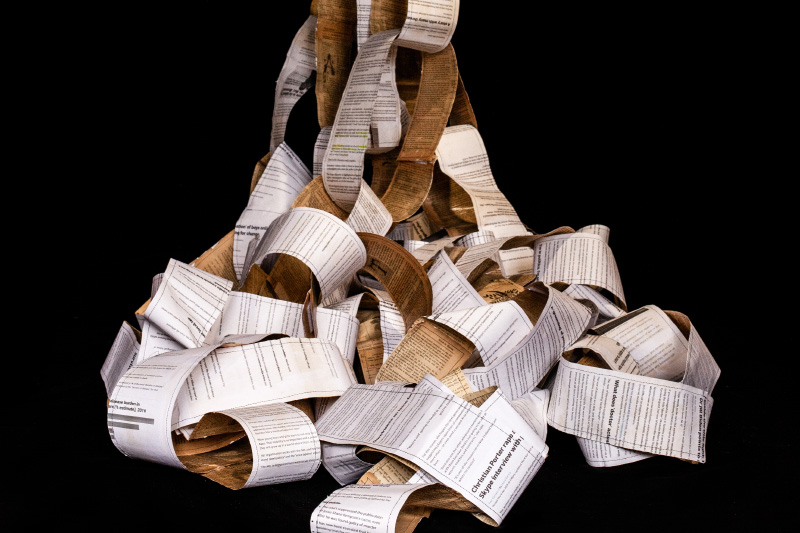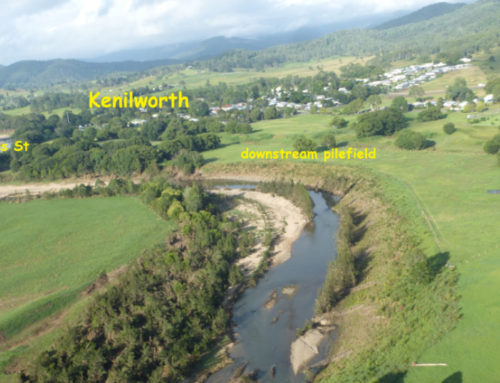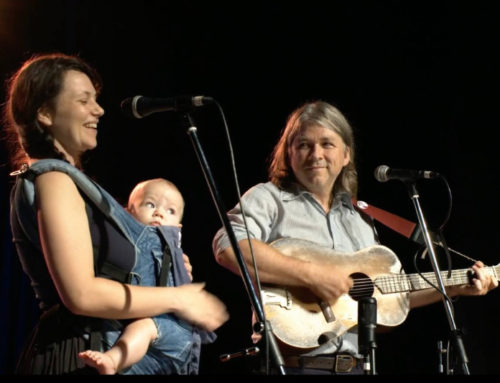Kathleen Hunt BA Fine Arts (hons), describes herself as a Green Metalsmith, or Greensmith. Her exhibition, Paper Chase, will be on display at Gympie Regional Gallery from 9 March until 14 April 2022. Zela Bissett talks with Kathleen about her methods, materials and motivations.
Zela: Were you artistic as a child? If so, were there people in your life who encouraged your artistic expression?
Kathleen: As a kid I was wandering around without shoes, pouring over art magazines and gardening, being solitary and difficult. Although always curious and a thinker, I was unaware of how the world worked. My grandparents had a large home and extensive garden – big enough to lose myself in when regularly banished there by my despairing mother. Time on my own, beyond four brothers and a much younger sister, became a feature of my life.
On completing school, it was considered that I was too unworldly to manage the transition from the isolated plains to a capital city, so I ended up in libraries, with texts and tomes still underpinning my arts practice. A sense of wonder, an interest in history and a love of the beautiful have always been with me. Pocket money came from drawing contour plans for the family construction business.
My parents, grandparents and great grandparents were all builders of community and I followed. Amateur dramatics, school music programmes, Arts Council committees, RADF boards, with a restaurant on the side, TAFE courses and a language course in Italy- anything creative. So I guess living a varied life, grabbing opportunities, taking risks in the context of continual learning prepared me for the life of an artist.
Zela: What artistic media are you most comfortable with?
Kathleen: Given that we are drowning in a sea of stuff, I’m interested in the concept of Waste As Resource, together with “entanglement and the physics of things” (Karen Barad, quantum physicist).
What engages me is the dialogue between materials, concept and process. As each series of works is inspired by different materials, new challenges are encountered, mostly centred around the marriage between the message and the particular medium, the concept of becoming and the resolution of connections, bringing me to connection as the key to remaking or restoring flourishing lifestyles and flourishing communities.
Zela: Your art concerns itself with social issues including violence against women. What provoked this interest for you?
Kathleen: 5 Dec 1788. After lodging a complaint to the Magistrate that her husband was beating her, pregnant convict Deborah Herbert was sentenced to receive 25 lashes (with a cat o’nine tails) for daring to complain and for bringing such a trivial matter before the court.
17 Feb 2020. Hannah Clarke (and her three children) were murdered by her husband and father of the children. For daring to leave her abusive husband and start a new life with her children?
After hearing that, the next day each of the 327 customers at the local news agency had made comment on this heinous crime, Backlash was conceived – as a way of distilling my response to these then, inexplicable deaths. Revealed was a culture of misogyny as a kind of enforcement strategy, controlling and punishing women who challenge male dominance. Further research saw religion wielded against women. The Bible (King James Version) is being used as justification for violence toward women, violence more prevalent amongst Anglicans than in the general Australian population.
The family Bible C1840, was deconstructed with the pages then pasted to the back of each of the harrowing printouts of abuse. With handling, the words of the fragile old pages crumble however, the contemporary narratives are robust and endure.
While indicating a direct link between the past and the present, the 26m chain alludes to the 260m long petition presented in 1891 by the Australian Suffragettes to the Parliament of Victoria. My current exhibition, Paper Chase, grew out of this work.
PS Deborah Herbert was my Great, Great, Great Grandmother.
Zela: Do you think that art is an effective way to reach people with new ideas?
Kathleen: What resonates with me is the response of painter and jewellery designer George Braque when posed this question. “Let us not try to convince, let us begin to make people more thoughtful”.
University of Melbourne academics De Beukelaer, Bresvar and Chistoff, in exploring Climate Futures, note that, “Art is now a permanent fixture at UN climate conferences”. In Paris, ARTCOP21 saw some 400 events that took place in 46 countries, maintaining that “artists can raise awareness, making complex scientific reports accessible and tangible”.
Kathleen you studied a fine arts degree. Can you tell me what new ideas and practices that introduced you to?
Kathleen: Studying Fine Arts (majoring in Jewellery and Small Objects) at Griffith University, Southbank campus, was hard work, but this was an experience I had craved, for decades. I’d dealt with death, conquered cancer and I was broke – how hard could it be?
Well, very, very hard. I was already an exhibiting artist, had owned and run an art gallery, worked with international makers and scholars, was familiar with art galleries and museums and considered myself competent in whatever I undertook. I was unprepared for the state of confusion and chaos (which I now see as part of the learning process) that accompanied me for the full five years.
However, I kept going because I yearned to be part of the bigger world, of the bigger conversations. An undergraduate degree had only laid the groundwork, but it had identified two areas I needed to explore extensively:
- developing an environmentally-sound arts practice and
- in the context of increasing environmental degradation, acting as an agent of change.
A post graduate degree followed where I explored sustainability and can now, with integrity, describe myself as a Greensmith. The University experience gave professional credibility to my voice as expressed in my work, access to many Master Classes and an entree into a professional group of makers. With the Jewellers and Metalsmith Group of Queensland I’ve exhibited in Brisbane, Sydney, Melbourne and USA, attended national conferences and connected with a network of creatives, thinkers and makers.
Zela: Are there any goals that you are aiming for in the future for your art?
Kathleen: Professional development has always been an important goal and one, historically, involving much travel and expense. We are fortunate to now find in the Wide Bay, Noosa and Sunshine Coast, councils giving strong support through bringing professional development opportunities to us, the artists/makers, in these fundamentally challenged pandemic times. An Artist’s Residency is on my wish list. My preference is to explore my own region and contribute to its artistic legacy. I’m also looking for a multi-disciplinary collaboration, perhaps partnering with another creative in sound or light, perhaps industry. And of course, there’s always the appeal of further study. My work has developed a performance and participatory element and I’ll develop this further.
Zela: What would you like to say to anyone who feels they have some artistic ability but might be reluctant to begin?
Kathleen: Many credible authorities support the idea that we are all creative. My mentor, artist and maker, Dr Libby Woodhams, maintains that we are all creative beings, illustrated most effectively in her workshops. Scholar and author Ellen Dissanayke says that, from the beginning, we are biologically predisposed to participate in art-like behaviour, and that creativity is one of the basic human needs. We all have this ability, we just need to access it in many differing ways. When exploring the artistic, we are just drawing out something inherent in us all.
Be bold, jump in – you’ve got nothing to lose but yourself.




